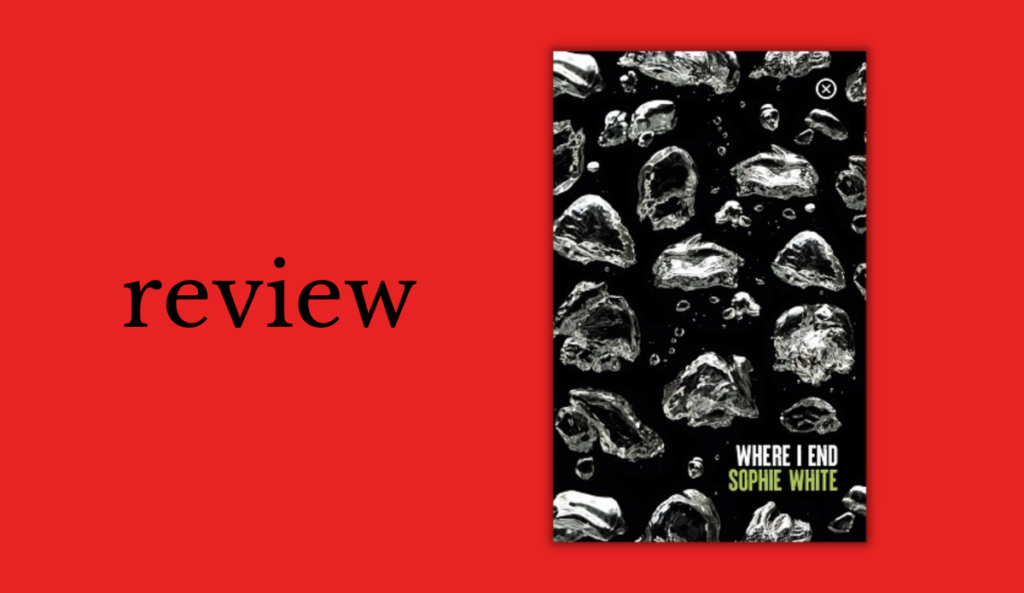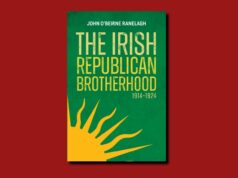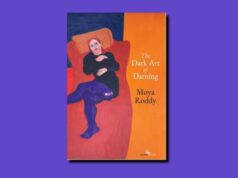
Where I End| Sophie White|Tramp Press|€15
“If men did pregnancy, more horror would look like this…”—Claire Hennessy reviews Where I End, by Sophie White
by Claire Hennessy
“If men did pregnancy,” Sophie White writes in her 2021 essay collection, Corpsing, “all those films about heroic space travel and war would never have been made and instead every action movie would be about pregnancy.”
Pregnancy, and motherhood, have it all: gory physical details, psychological terror, overwhelming love. These are already-fraught states of existence further complicated by mental illness, a topic White has personal experience of and has explored throughout her writing and podcasting. The recurring question posed in much of her work is this: how do women cope with the horrors of life?
In Corpsing and White’s first book, Recipes for a Nervous Breakdown, the horrors live within: the strangeness of childbirth or the wretched void in one’s own brain.
In her lighter, pastel-covered novels, the dark places still haunt her heroines; like Marian Keyes, White lures you in with wit and warmth and then devastates with emotional truths.
There is astute social commentary, as one would expect from someone with a regular column; these are books that often speak to our specific cultural moment, and its toxic relationship with presenting outward perfection as rates of mental distress soar.
Islands—language, otherness
Where I End is something a little bit different; tighter than White’s previous books and removed from ‘today’ in both distance and time. It is set pre-smartphones, on an island off the Irish coast, “a treasure” according to brochures and bleak as hell according to those who live there.
The narrator of this novella, nineteen-year-old Aoileann, “can never decide which part of the island I hate most. The cliffs are devious, they could draw you over. The beach feels less perilous, but there’s a murky feeling in my stomach when I stand and look out from there. I think I can see the hidden part of the island, the part that is submerged. Under the water’s surface, it runs away from me, granite slabs falling back into the black. I don’t like that when I can see of the island is only a sliver of its full awful self. I don’t like that the rest of the island is lurking beneath us.”
Small islands – isolated, claustrophobic – are ideal settings for sinister goings-on, and other writers of White’s generation have made use of them in Irish-set psychological thrillers and mysteries (see Louise O’Neill’s After The Silence, Lucy Foley’s The Guest List, and Caroline O’Donoghue’s Scenes of a Graphic Nature).
There are certain resonances across these books and Where I End, as one might expect, but it is also in conversation with works that focus on how these islands cling to the Irish language and its myths longer than the corruptible, corrupted mainland – Synge, of course, but also more recently Audrey Magee’s Booker-longlisted The Colony.
White does not fold too much of the language in, but – similar to Brian Friel’s Translations – we are reminded, often, that the islanders use this language more than English. That there is a difference, an otherness, a strangeness – much like the landscape.
Topography of human flesh
But for all that White benefits from this evocative, gothic setting, it is the topography of human flesh that really interests her.
Aoileann and her grandmother care for her mother, “the bed-thing”, who never speaks and yet scratches desperately at the floor with her ragged hands. “Only the nails on her thumb remain. The fingers mostly end just past the knuckles. The pad of her right index finger has worn away entirely and the bone extends like a tiny pick from the flesh.”
Washing her each day is an ordeal that begins with looping leather belts around her, strapping her to a chair, tilting and dragging it to the bathroom, and then refastening the belts to readjust the body. It is gruesome and yet often dispassionately rendered. Aoileann tries to look at the body “only in small morsels.”
The disgust Aoileann feels and the endless repetition of attending to another’s bodily needs at are odds with what we expect from women and those seemingly natural instincts to mind and soothe.
“Her folds of skin are a nuisance,” she notes of her mother. “Despite her seemingly lifeless petrification, opportunistic bacteria and fungi find life enough in her to breed in places where her skin pleats and gathers . . . Unused bodies reek. They reek worse than the rest of us because the reek ferments in the crevasses. She is putrid. She is decaying. Between baths we swab her but we’re battling a rancid tide.”
Re-seeing the female body
In sharp contrast, the body of an outsider, Rachel, a new mother and artist on the island for a retreat, is luscious. Aoileann encounters her on the beach and is in awe:
“Through the damp white I can see the shadowy hints of her nipples and her pubic hair. Her body, her fullness, amazes me and I’m shy. She looks so juicy and healthy and delicious. Her body is large and generous, spilling and quivering. The urge to touch her takes my hands and I must ball them into fists to make sure they don’t plunge forward to feel her.”
There is a deliberate blurring of the maternal and sexual when it comes to Rachel, who serves as the impetus for Aoileann to step beyond her normal life. White wants the reader to squirm, to be uncomfortable, to re-see the female body, the mothering body. She succeeds.
If men did pregnancy, more horror would look like this: everyday caring with the volume turned up slightly and slowly until it is a scream that chills you to your insides, and echoes long into the night.












